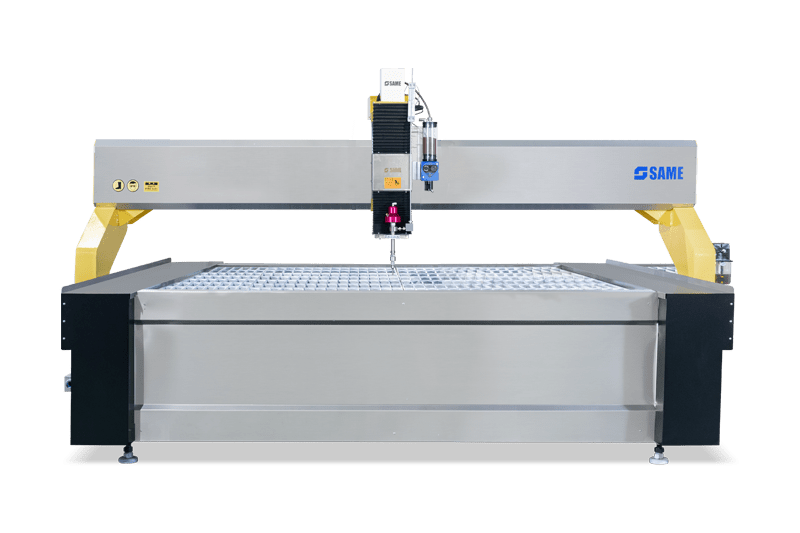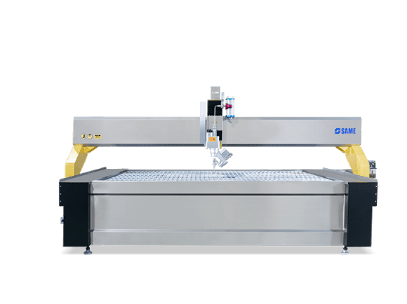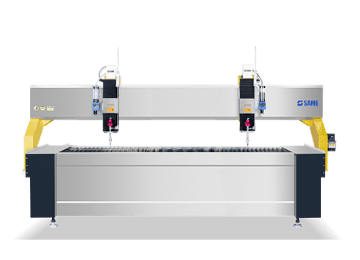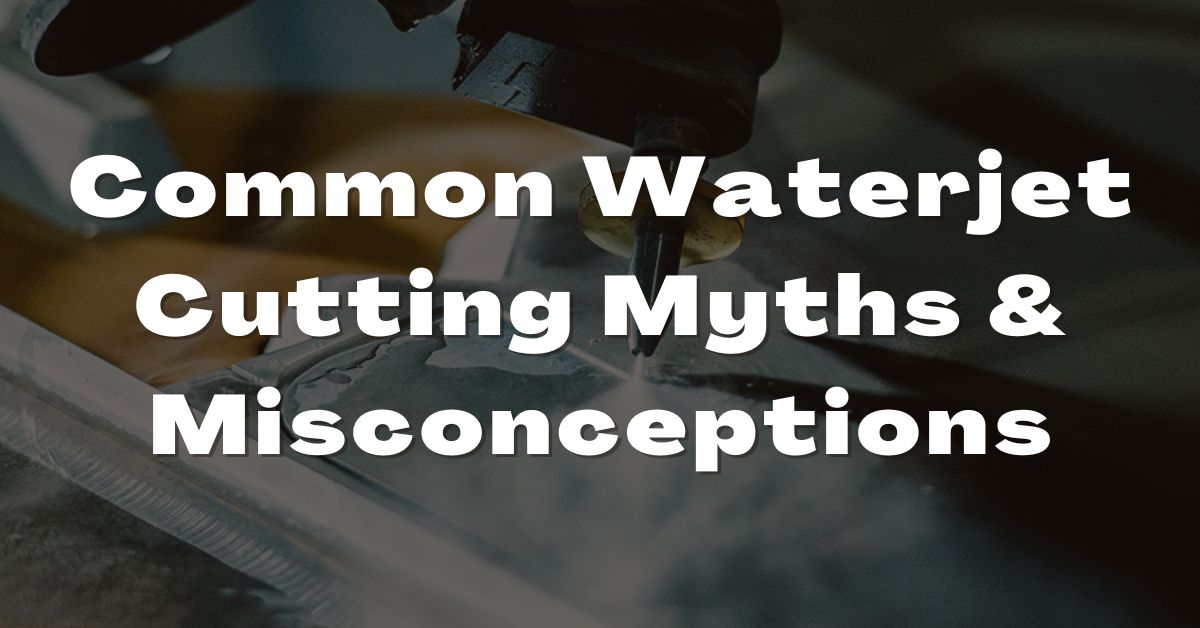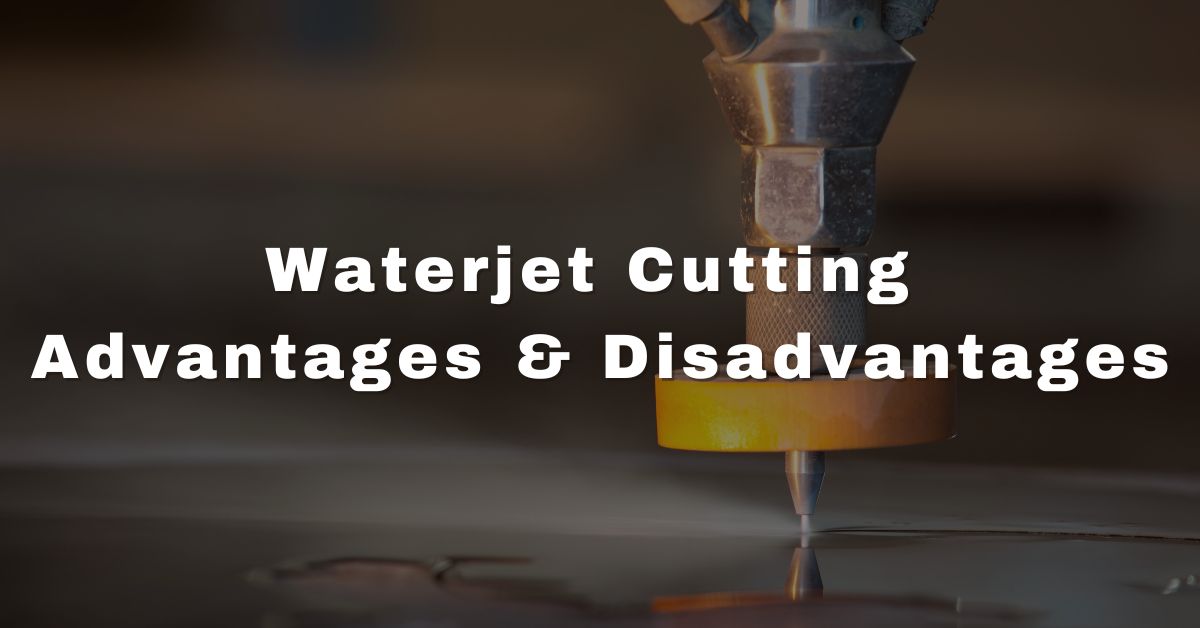Summary
Waterjets have proven to be a very prominent and efficient way of cutting different types of materials. Glass is one of those materials which fall within the broad spectrum of materials that can be easily cut with waterjets.
Waterjet cutting glass requires you to be careful, efficient, and precise to get the job done as smoothly and cunningly as possible. However, even though abrasive waterjets can come with the right tools, they still will require changes and guidance to get the cutting done right. And in this article, I will try my best to teach you how to do that.
WaterJet Cutting Glass: Everything You Need to Know!

Can you cut Glass with a Waterjet?
Waterjets can cut through glass efficiently and smoothly without interfering or messing up the internal structure of the glass. All this is possible due to the various modifications that can be implemented.
The cutter connected with a high-pressure water-pump accelerates the water stream out of the nozzle within a controlled set speed. To further assist the WaterJet Cutting Glass, the water stream is mixed with abrasives such as garnet and aluminum oxide.
Even complicated cuts can be done smoothly and economically thanks to their controlling water stream technology. The jet stream is accurate enough to cut materials down at about 0.1mm thickness thanks to their pinpoint precision.
Must Read: What Materials Can a Waterjet Cut?
You can be efficient in terms of money and time whilst cutting glass with water as even the most complex forms of glass can be cut with little to no distortion. As waterjet cutting is a non-thermal method, there will be no heat-affected zones present in your waterjet cutting glass subjects.
On the other hand, your glass won’t be vibrating when it is being cut with a waterjet, there is no need for a second cut or unfinished edges to worry about.
Can you Cut Tempered Glass with Waterjet?
Let’s deal with it, not even the strongest form of weapons can bring down foes that just don’t give up when it comes to being cut.
In this case, tempered glass is a strong foe that just refuses to yield itself into being cut.
Why may you ask?
Because these glasses were designed to break and shatter into millions of tiny fragments once they reach their ultimate tensile strength. This means, they are already under immense stress and any additional force acting on them will simply cause them to break apart.
These forms of glasses are famously known to resist the urge of being cut or manipulated around when applied pressure. These glasses are indeed not meant to be cut, even the slightest pressure from waterjet will simply split them apart in pieces.
Hence, it’s rather not advised that you try cutting down tempered glasses with waterjets. Sorry glass cutting enthusiasts!
Can a Waterjet Cut Bulletproof Glass?
Bulletproof glasses have been proven to withstand almost 30 rounds of the AK-47 Rifle. However, a 60,000 PSI of waterjet stream isn’t something they can live up-to in terms of providing protection!
Waterjet can easily curve out and stroll through 2-inch of solid bulletproof glass and ironically even carve out the shape of an actual bullet into the glass. Funny enough, although bulletproof glasses can withstand almost any sort of projectiles, a water stream isn’t something that it can tackle just as easily.
Imagine a 60,000 PSI waterjet stream releasing a gun being shot towards a bulletproof glass, whoever is behind it will surely be dead meat!
Can Waterjets Cut Mirrors?
This is a huge problem for some cutting machines which use a pin-point laser to cut through, the immense reflectiveness of mirrors can only spell disaster. However, a more economical, less disastrous method of cutting mirrors is handed over to waterjets.
Thanks to its cold and continuous cutting process, no amount of reflection can protect mirrors from being cut by waterjets. It will pierce right through and steadily cut across mirrors without causing cracks or flinging glass particles across.
Can Waterjet Cut Float Glass?
Float glasses (Soda Lime & Low Iron) can be easily fabricated into simple cut-outs, shapes, holes, and much more using an abrasive waterjet cutting method. Using the precision glass cutting settings in the fabrication capabilities will allow you to smoothly cut through float glass.
Use an abrasive waterjet with higher mesh preferably in the range 100-150 to have smoother edges and finish in the final piece.
With the right pressure and thickness of the stream, even certain piercings are possible to be done in float glasses.
Can you Cut Glass Tiles with Waterjets?
Need to cut yourself some pieces of glass tiles to decorate your home? No worries as you can safely insert any glass tile block of your choice and cut them in your required shape with ease. Glass tiles are harder than most glasses and hence are easier to be cut and or handled while under waterjet stream.
A high-pressure abrasive waterjet can get the job done in no time and you won’t have to worry about any damages or distortion on the final piece either.
Glass tiles cut comparatively better than other glass types thanks to their immense high resilience and hardness. This is because you won’t have to use brittle cutting mode or pay heed to extra carefulness as you do with other glass types.
Can you cut Stained glass with Waterjet?
Traditionally most artists usually use an excruciatingly tough hand-operated method to get the cutting of stained glasses done. However, after waterjets became popular onto the market, they couldn’t have done their artwork any better thanks to the pinpoint precision and control that waterjets provide.
Also Read: Waterjet vs Laser vs Plasma Cutting
Artists and architects can easily get their job done with the help of waterjets to cut through stained glasses. The thinness of the stained glass allows for single-pass cutting and also is an economical way by reducing scrap produced while cutting as well! This allows for recycling of stained glasses for future uses ahead.
Can Mosaic Glass Tiles be cut with Waterjets?
Mosaic Glass tiles are thicker and stronger than most glasses, so will require higher pressure and perhaps will require you to have some patience on the go as well. However, the need for making detailed changes in pressure and nozzle angle won’t be as much necessary as these tiles can be cut easily.
Nevertheless, this isn’t where it ends, you can make signature designed mosaic glass tiles thanks to waterjet immense designing and precise capability. You can use a waterjet to make softer or curvier lines whilst also benefiting from the sustainability of each material present.
It’s almost as if you can go all free-hand for any sort of architectural uses with waterjet cut mosaic tiles. Any shape or form can be manipulated within the mosaic tiles to create a mesmerizing beauty that will keep an utmost dazzling impression for your guests. Honestly, you can’t expect any better or smoother cutting anywhere other than waterjets.
Can Windshields or Laminated Glass Be Cut with a Waterjet?
Windshields or laminated glasses usually suffer from some traditional risks when cut through sandblasting, diamond wheels, or glass cutters. Hence, this is something that should also be best left in the hands of the machine if you’re expecting the best results. In simple words, there won’t be any regrets as delamination can be controlled based on the settings you use.
Try piercing as little as possible to prevent any delamination, you should even try using low pressure to control chances of any piercing or delamination. Though you might have to be extra careful during operation on your end, do expect this to be a cost-effective and efficient way of cutting laminated glass.
Laminated materials have many layers and while piercing through layers using waterjet it’s very common for waterjet to pass through side-way and cause delamination. However, the high stream usually only goes in one subsequent direction and the safest solution to this is to have pre-drilled holes in your laminated glass before.
Thinner laminated glasses have less probability of being delaminated as they can pierce very easily without chances of water ending up in unwanted areas. As for you to make small holes in glass, usually decrease the waterjet stream thickness, use abrasives, and use lower pressure to make piercings without breaking the material.
How WaterJet Cutting Glass Works?
Here is a brief description of how most glass types can be cut. This applies for most cases, however; besides of WaterJet Cutting Glass, some glasses may require other ways to be cut.
Use abrasives such as garnet or aluminum oxide along with water jet at a stream pressure of about 10,000-20,000 PSI.
Make sure the timing of the abrasives joining the water stream is pitch-perfect, as water with no abrasives will crack and ruin the glass. Get the settings and mixture just about right to get the job done with no losses!
Turn on the abrasive flow before the water to make it flow with the water during the cutting process. You may even use plywood on top of your glass so that it absorbs the force in before the flow is corrected. This will give time to properly make the abrasives and water reach sufficient pressure to mix in before the waterjet cutting glass process commences.
For most glasses that are brittle or prone to being damaged, it’s better to have extra material on the bottom of the glass to support them. These may be dense Styrofoam or plywood.
These must be soft enough for water to not jump back into the glass to cause damage nor should cause any frosting of the glass in the bottom. This will also provide an even surface for the glass to safely lie at.
Also Read: 10 Waterjet Cutting Safety Tips
Make premature piercings when you’re designing to prevent any formation of cracks along with the glass. You can do this by using lead-in to further stray the piercings towards the end of the glass or maybe use any piercing methods that are suitable for you and the material. For instance, turn on the ‘very brittle mode’ when working with fragile glass.
Your glass materials may get heated up from the water catch tank due to the dissipation of energy given out from high-pressure water. Avoid letting it rest or cleaning it with ice-cold water as it may crack the result and cause shattering.
Use industrial quality abrasives with a higher mesh size than usual within the range of 100-150 to have a smoother yet clean finish around the edges.
The immense depth of knowledge and information that’s available to cover up various aspects of WaterJet Cutting Glass is quite enormous. Hence, I would rather advise you to go out and check SWaterJet.com website to get a far better idea about the whole process of WaterJet Cutting Glass.
Conclusion
That’s all that we had to provide regarding waterjet cutting glass.
Can it be done?
Obviously in the most efficient and cost-effective way. Though you can expect some bumps and needy adjustments to be made from time-to-time it’s still very doable and definite worth taking a shot at.




